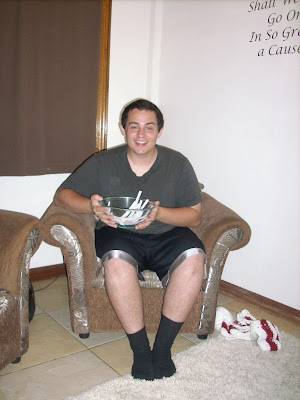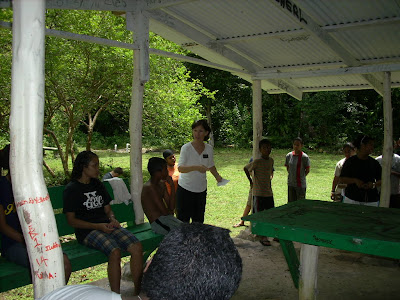This past Sunday our Sacrament meeting theme was the power of example. Speakers discussed people who have been good examples to them and reminded them of the Savior. For our special musical number Courtney Trevet sang a primary song called “The Things I Do”. The words to the song are as follows: “I’m much too young to go abroad To teach and preach the word of God. But I can show I know it’s true, Quite simply, by the thing I do. The people in my neighborhood Will judge the gospel bad or good By how I act at work and play, And not just on the Sabbath day. I’ll take my friend to church with me, Where I will act with dignity, My reverence and my happy face Will tell him it’s a sacred place. In everything I do he’ll see I am what I profess to be. Then when the elders find his door, He’ll say, ‘Come in and tell me more.’”
Elder Johnsen had a hard time reaching 8 year-old Courtney on Saturday to follow-up on her progress with the song but the phone was finally not busy about 9:00 p.m. –the family shares a phone with the neighbor, it must be cordless because when Elder J asked for Pam he could hear the phone being carried down the hill and as the phone approached the house he heard Pam (Courtney’s mom) playing the electronic keyboard. The piano stopped and then Pam came on the line. Elder J asked her if Courtney was ready—she said that Courtney would never let them forget a singing assignment. She asked me if I wanted to hear a few bars of the song—of course, I said yes. Then Courtney came on the line—and in perfect pitch and great articulation (with no accompaniment) she sang the first 9 bars of the song—it was so cute and fun. On Sunday morning the whole family was in their seat 15 minutes before the meeting began. Courtney introduced Elder Johnsen to a friend that she had brought to church (just as the song lyrics suggest) life imitating art! The sacrament meeting performance was as flawless as was the rehearsal was over the phone.
Speaking of Life Imitating Art, Elder J had some fun with his youth SS lesson this week thanks to an idea that came from LDS Living and the 3 pigs. (BTW we're getting a lot of mileage out of the 3 pigs on this mission, 12 angry pigs, etc, what's up with that, ha).
He read to his students a brief version of The Story of the Three Pigs (the version in which the mother sends them into the world by telling them “Whatever you do, do it the best that you can because that’s the way to get along in the world” and the first two pigs are eaten by the wolf), and invited them to take a look at Helaman 5:12 and find the parallels.
"And now, my sons, remember, remember that it is upon the rock of our Redeemer, who is Christ, the Son of God, that ye must build your foundation; that when the devil shall send forth his mighty winds, yea, his shafts in the whirlwind, yea, when all his hail and his mighty storm shall beat upon you, it shall have no power over you to drag you down to the gulf of misery and endless wo, because of the rock upon which ye are built, which is a sure foundation, a foundation whereon if men build they cannot fail." (Hel. 5:12).
The word parable comes from the Greek language and means “side by side.” A parable is really two stories, side by side, one is told, the other, is implied. We had fun in class trying to make the application of the elements of the Three Pigs to our own lives in mortality.
-Who is the parent who sends his sons out to seek their fortune?
-What is the road down which the pigs travel?
-Who are the pigs?
-What are the elements with which they choose to build their houses—the straw, sticks, and bricks?
-Who is the wolf?
-What is the huffing and puffing which causes some houses to fall?
-What is the road down which the pigs travel?
-Who are the pigs?
-What are the elements with which they choose to build their houses—the straw, sticks, and bricks?
-Who is the wolf?
-What is the huffing and puffing which causes some houses to fall?
As we reviewed the first 5 chapters of Heleman we tried to notice the kinds of houses (figuratively) the Nephites were living in at different points in the narrative. For example,
-Helaman 4:13 is probably a straw house.
-Helaman 3:1 might be a stick house.
-Helaman 3:24-26 seems to indicate a brick house.
-Helaman 3:1 might be a stick house.
-Helaman 3:24-26 seems to indicate a brick house.
It's sort of interesting to consider these 3 types of houses in terms of living 3 realms lives also, telestial, terrestrial and celestial. This matter of building on the Rock of Christ is referred to throughout the scriptures, as are the storms (the huffing and puffing) of Lucifer. Perhaps the most dramatic passage is found at the end of the Sermon on the Mount and the Sermon at the Temple:
“Therefore whosoever heareth these sayings of mine, and doeth them, I will liken him unto a wise man, which built his house upon a rock: And the rain descended, and the floods came, and the winds blew, and beat upon that house; and it fell not: for it was founded upon a rock. And every one that heareth these sayings of mine, and doeth them not, shall be likened unto a foolish man, which built his house upon the sand: And the rain descended, and the floods came, and the winds blew, and beat upon that house; and it fell: and great was the fall of it” (Matthew 7:24-27; 3 Nephi 14:24-27).
Of course, not everything built out of bricks is best,. For example, cartoonist Steve Moore, notes: “The pig watched his two friends run into the surf with boards made of straw and sticks. Later however, his smug sense of security – along with his board of bricks –vanished in about 40 feet of water.”
Elder Gubler and Fullmer had an interesting experience this week a guy who had been heavily drinking and was threatening suicide approached them with a question, “My wife is committing adultery, what should I do?" What they did was walked and talked to the guy, went down to the beach near the Palau Pacific Resort and skipped rocks into the ocean. After about 45 minutes of walking and talking and skipping rocks the crisis was past--they had a return appointment with him scheduled it will be interesting to hear the rest of the story. They really felt that encounter was a case of divine positioning. Elder J thought the scenario seemed like a script from a movie, Life imitating Art.
Some of our blog readers may know that our son Clark who is a singer, actor, and dancer on Broadway is currently performing in the wildly popular Tony award winning “The Book of Mormon” musical. This past week he was interviewed on national TV (NBC’s Rock Center) Mormon in America segment where he described not only his experience playing a missionary in the show, but also how he actually served as a missionary in Mexico. He happened to mention that Elder and Sister Johnsen were currently serving in Palau on a mission and our picture (taken in Peleliu, during youth conference) was displayed. So many people have commented to us that Clark did a great job sharing his feelings about his missionary endeavors in Mexico as one of his life greatest experiences and how he relives that experience 8 times a week in the show. In his case, Art is imitating Life.
We are very reluctant celebrities, however, we affirm, with Clark that serving a mission is one of life’s greatest experiences. Our life is imitating his art.





































